Sweeping in China

Sweeping in China |
 |
Hong Kong's Mechanical Street Sweeping Programby Ranger Kidwell-Ross
Mr. Wilson Lee, Superintendent of Cleansing & Hygiene for the Hong Kong Food and Environmental Hygiene Department (FEHD), met me in the lobby of the Sheraton at 2 PM sharp, exactly as promised. Dressed in a nicely tailored blue suit and tie, 'Wilson,' -- the western pronunciation of his Chinese given name, Wai-ching, -- proved to be as sharp as his attire. 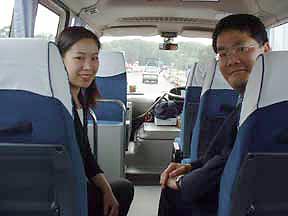
With the brisk steps that characterize how business is done in Hong Kong, we headed out to the street. Wilson motioned to our left toward a spotless white government van that was pulled up at the curb, door open, waiting for our arrival. Inside, in addition to the smiling driver whose name I didn't catch, was Jessey Kong, who was along as the FEHD public relations representative. As soon as introductions were made, the driver took off into the bustling street with the polished skill of a professional. Although traffic travels on the opposite side of the street than in the U.S., so far it's been almost impossible to tell. That's because virtually all the streets seem to be one way. With steering wheels on the right, crossing the street as a pedestrian is especially disconcerting, since cars turning the corner give the spooky illusion of having no driver. The downtown area of Kowloon, where my hotel is located, has an incredible crush of traffic -- including buses of all shape, size and description -- all vying for the same real estate as the mass of pedestrians. Many of the packed side streets don't even have stop signs. I was very glad to have an obviously experienced driver at the wheel, since with the way traffic moves on the frenetic streets of Hong Kong, it wouldn't take long for a 'Gweilo'* like me to end up in trouble. 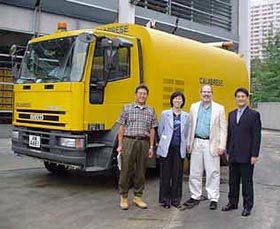
Wilson explained we were heading for the New Territories District Municipal Facility, one of the primary locations for municipal equipment operations. During the 20-minute trip to our destination, Jessey, Wilson, and I spent some time getting to know one another. Although he'd not had much time to investigate my interview request, Wilson was well prepared, including printouts of portions of our website, which he had sorted neatly into his business folder. 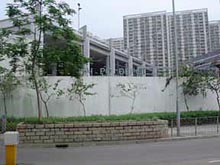
I could tell they were both surprised at the idea of a visit by someone who specialized in the sweeping industry. Like in America, I got the feeling that in Hong Kong, too, the fact of pavement cleaning goes largely unnoticed by the general population. You know the drill: No one notices when the pavement's clean, it's just when trash starts piling up that the phones start to ring. If that's the case, the phones at the Hong Kong FEHD must be pretty quiet, I joked with my hosts that I could say in my article that their Department was so named because the streets of Hong Kong were clean enough to eat off of. From what I've seen so far, that sure seems to be a fact. Although the air is, at the moment anyway, somewhat thick with pollution, the pavement everywhere is cleaner than in most American cities I've ever seen. I was soon to learn why. When we pulled into the service facility, an impressive array of Department representatives was on hand to greet me. At the head was Mary Leung, Chief Transport Services Officer responsible for the fleet of municipal equipment in the New Territories areas. Introductions were made all around before we headed upstairs to a 2nd floor conference room to discuss how sweeping is done in Hong Kong, crown jewel of the Orient. Inside, on the wall facing the stairway, was a nice collage of large-size photos showing all the types, makes and models of equipment used in the region. All were painted the distinctive yellow chosen, because of its safety factor and visibility, for the Departmental vehicles. 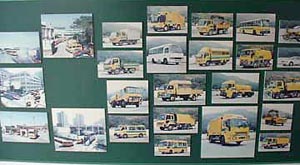
In our meeting, which was also attended by the manager of the mechanics, Leung Yau Chuen and several other gentlemen who listened attentively but did not speak. I learned how sweeping services in Hong Kong are provided. The Tai Po Vehicle Depot, where we were sitting, was just one of the FEHD vehicle depots. The whole department has 10 depots. The NT region operates 20 of the 45 sweepers currently in use, and these are apportioned among the 5 NT depots that are involved in doing mechanical sweeping. The other 25 sweepers are spread among the other regions. Mechanical sweeping is done only on the fast-moving roadways, flyovers and central road dividers in Hong Kong. All of these are swept according to pre-planned programs using air sweepers. The downtown core and slower-moving urban roadways are swept via an alternative method, which will be the subject of our next story installment. 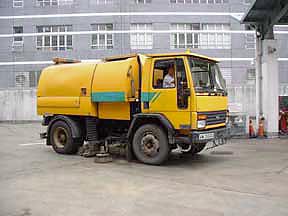 The fleet of mechanical sweepers is composed primarily of Johnston 600s, of which they have a total of 39. The Johnstons have long been the machine of choice. For those who don't know how Johnston 600s operate, they employ smallish curb brooms that transfer debris directly to the suction nozzle, on the side nearest the nozzle, and on the side the curb broom directs debris to a transfer brush that pushes it to the far side of the head where the suction nozzle is located. However, in the last year the composition of their sweeper fleet has changed. Mary explained that their sweepers are purchased by bid -- what they call 'tender'. And, last year for the first time the low bid ended up being an Italian-built competitor, the Calabrese model S250. The Calabrese units came in at about $850,000 HK, less than the tendered price of the Johnstons (at the time of this article, the exchange rate is $7.8 HK to $1 U.S.). So, suddenly new to the Hong Kong fleet are 6 Calabrese sweepers. 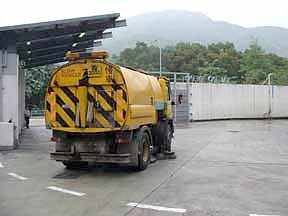
As is often the case with any venue where the long-standing product of choice suddenly changes, it was clear that so far the NT crew aren't impressed with the required change-over. "The Calbrese sweepers met the basic requirements of the bid," said Mary, "but the Johnston sweepers to us were not just a shirt, but a shirt with a tie or a bow tie. For example, the Calabrese sweepers are wider and about 1 foot taller, and where our roads are narrower these [Calabrese] sweepers are more difficult to maneuver. And because they are taller they can hit the trees in some places." She also spoke of some design problems. "With the Johnstons, the water inlet is at the side and the operator can get water in 15 minutes; with the Calabrese it can be up to an hour. We asked the Calabrese people to modify it, so now it's somewhat faster, but due to the design we can't get them to put the water [inlet] onto the side. It is very difficult for drivers to get to." "Also," enjoined the head of the mechanic team, "on the new Calabrese sweepers the air filter has to be replaced every 3 weeks, and the Johnstons will go a month. That increases the cost of operating them." There are 37 sweeping routes throughout Hong Kong. About 50% of these are swept in the daytime and the others at midnight. The reason the majority of streets can be swept during the day, I was told, is because the traffic isn't all that bad. Although I had only been in Hong Kong for less than a full day, to me this clearly seemed a matter of perspective. "Nighttime sweeping is primarily needed in Hong Kong's more urban areas," said Mary. "Most of the time the sweepers can be out alone in traffic, although when the traffic is very busy or the roads have some dangerous corners, then, we arrange to have the police cordon off the area before the sweeper comes into it. For safety, all the machines in the department are painted yellow, and all the sweepers have the standard accompaniment of flashing yellow light bars." During our interview, much emphasis was placed on the district's choice of this color in order to make its equipment bright, safe and easy to see. "Debris disposal depends upon the location being swept," said Wilson. "In some depots, where our serving area is near a landfill, the debris is dumped directly there. In the more urban areas we have refuse transfer stations (RTS), where debris is dumped from the sweepers and then transferred to landfills for final disposal. All our landfills are located in the more remote areas. We prefer to have the sweepers dump at an RTS, since that's easier on the sweepers. The landfills are often very bumpy and uneven, and that's hard on the sweeper because they have so little clearance." Given the amount of traffic I saw on the streets, the sweeper-involved accident rate cited was exemplary, only about one per year. Accident prevention is why they have taken every preventive method possible; light bars, strips that are reflective and painting the sweeper the bright yellow color. It will come as no surprise to most of our readers that when accidents do happen that involve Hong Kong sweepers, it's usually late at night and involves a sleepy driver coming up too fast from behind. The extent of operator training is the usual specification that the manufacturer has to provide training in Cantonese at time of delivery, along with manuals. In addition to factory training, the Department also employs driving instructors for new operators and training on safe driving. As there are many makes and models of municipal vehicles in the fleet, the Department now requests in its tenders of municipal vehicles that manufacturers also supply video training. That way, explained Mary, we have something to show our drivers later when someone new is taking over because of retirement. It's very good to use as a supplement to actual hands-on operating experience. Sweeper drivers earn about $15,000 HK per month, as well as medical, annual leave and an eventual pension after working for at least 10 years. Retirement age is 55. Something quite new with the way things are done here is that the government is now moving towards contracting-out of sweeping services. This is a marked departure to the Chinese way of doing things, where services have historically been provided and controlled by government agencies. However, in the changing Chinese climate of free enterprise there is a lid on increasing government services. In the long term, they are looking at moving toward contracting out about 50% of sweeping services. This will be done, Wilson explained, as workers retire and otherwise leave their employ. I found Hong Kong to be a magical mix of old and new, a melting pot of technology and tradition. These are swirling together to create a 21st century highway that's being built by a culturally-rich mixture of political and economic forces. Although my visit to Beijing is still to come, my expectation is that Hong Kong is setting the pace of change for the rest of China. Where that road will lead remains to be seen, but in the hands of my gracious and competent hosts at the Hong Kong Food and Environmental Hygiene Department, there's no doubt the way will be sparkling clean. We also have a companion story to this one online that discusses Hong Kong's manual (human labor) sweeper program that deploys into action 2,300 workers per day. This story was one written during our editor's trip to Asia in 2001 to investigate how sweeping was done there. While he was there, Ranger wrote an online journal for the sweeping industry. You may still view this online journal, which won a U.S. APEX Award for Online Journalism, in our archives. * Gweilo (pron: Gah wy low, also sometimes spelled Gueilo) is an ancient slang word from back when white people first showed up in Asia. It's not all that common a usage, however even though it translates literally to 'white devil,' it doesn't have a bad connotation. It's about like the word 'Haole' from the Hawaiian culture. Back to Story
|